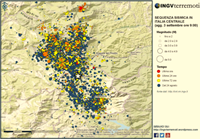The role of INGVterremoti blog in information management during the earthquake emergency in Central Italy
Pignone M., C. Nostro, A. Amato, C. Meletti (2016).
Annals of Geophysics, 59, Fast Track 5, doi: 10.4401/ag-7261
Abstract
In this paper, we describe the role the INGVterremoti blog in information management during the first part of the earthquake sequence in central Italy (August 24 to September 30). In the last four years, we have been working on the INGVterremoti blog in order to provide quick updates on the ongoing seismic activity in Italy and in-depth scientific information. These include articles on specific historical earthquakes, seismic hazard, geological interpretations, source models from different type of data, effects at the surface, and so on. We have delivered information in quasi-real-time also about all the recent magnitude M≥4.0 earthquakes in Italy, the strongest events in the Mediterranean and in the world. During the 2016 central Italy, the INGVterremoti blog has continuously released information about seismic sequences with three types of posts: i) updates on the ongoing seismic activity; ii) reports on the activities carried out by the INGV teams in the field and any other working groups; iii) in-depth scientific articles describing some specific analysis and results. All the blog posts have been shared automatically and in real time on the other social media of the INGVterremoti platform, also to counter the bad information and to fight rumors. These include Facebook, Twitter and INGVterremoti App on IOS and Android. As well, both the main INGV home page (http://www.ingv.it) and the INGV earthquake portal (http://terremoti.ingv.it) have published the contents of the blog on dedicated pages that were fed automatically. The work done day by day on the INGVterremoti blog has been coordinated with the INGV Press Office that has written several press releases based on the contents of the blog. Since August 24, 53 articles were published on the blog they have had more than 1.9 million views and 1 million visitors. The peak in the number of views, which was more than 800,000 in a single day, was registered on August 24, 2016, following the M 6.0 earthquake.
http://www.annalsofgeophysics.eu/index.php/annals/article/view/7261


